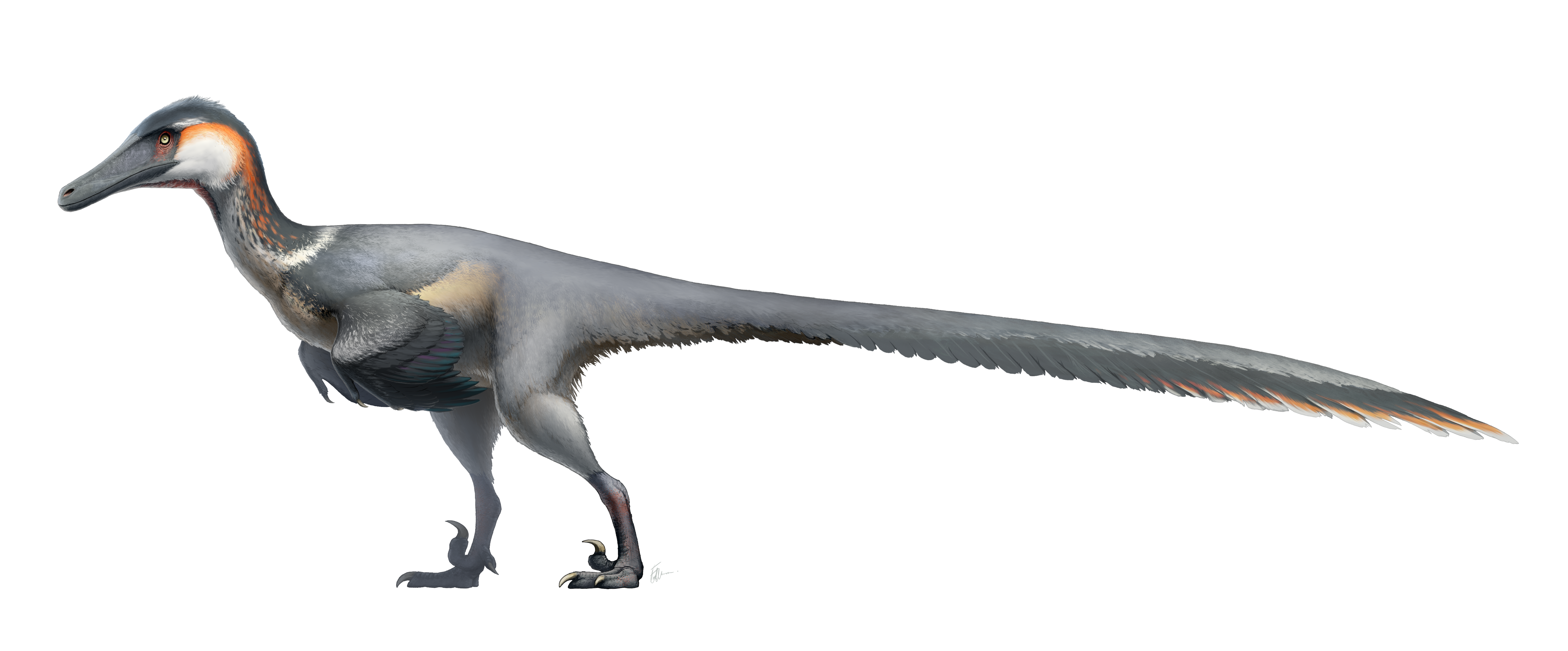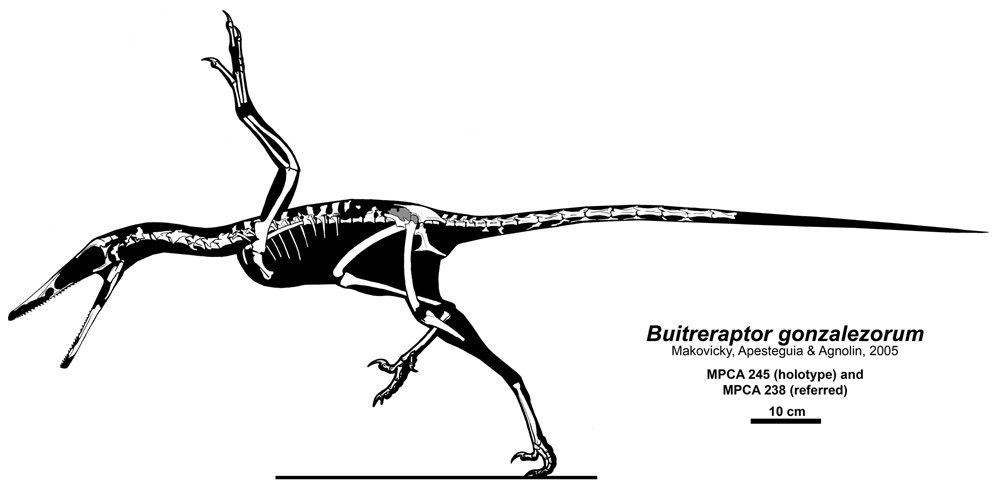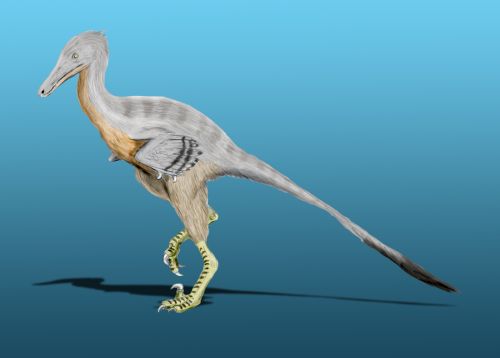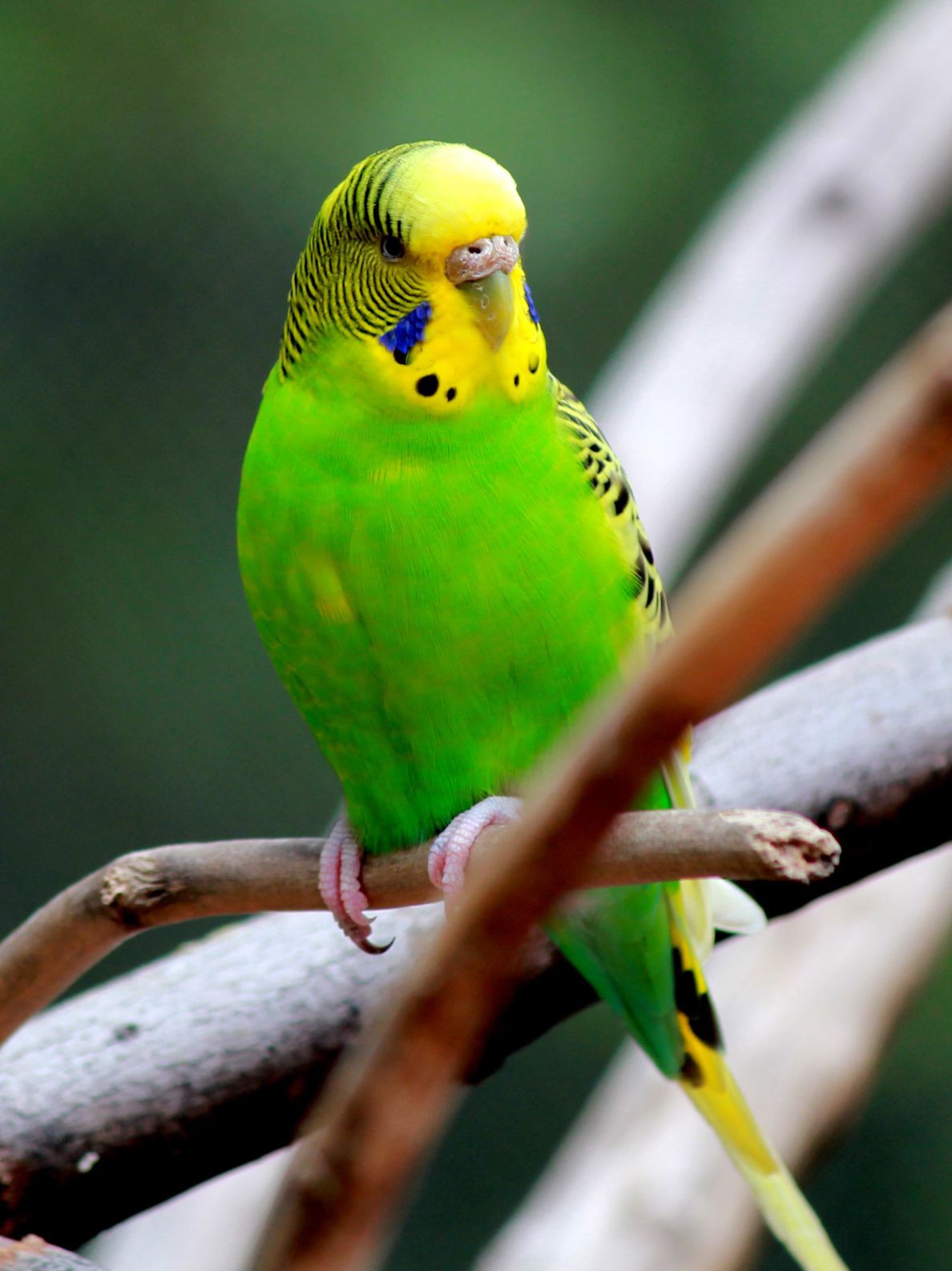|
Unenlagiines
Unenlagiinae is a subfamily of long-snouted paravian theropods. They are traditionally considered to be members of Dromaeosauridae, though some authors place them into their own family, Unenlagiidae, alongside the subfamily Halszkaraptorinae. Unenlagiines are known from South America, with possible unenlagiines being known from North America, Madagascar, Europe, and even Australia. Description Most unenlagiines have been discovered in Argentina. The largest was ''Austroraptor'', which measured up to 5–6 m (16.4–19.7 ft) in length, making it also one of the largest dromaeosaurids. The subfamily is distinguished from other dromaeosaurids by a tail stiffened by lengthy chevrons and superior processes, a reduced second pedal ungual, a posteriorly oriented pubis and very elongated snouts. Unenlagiines also had elongated, slender hindlimbs with a subarctometatarsalian metatarsus, which is characterized by the pinched metatarsal III at the upper end. Their distinct anatomy f ... [...More Info...] [...Related Items...] OR: [Wikipedia] [Google] [Baidu] |
Austroraptor Restoration
''Austroraptor'' ( ) is a genus of large dromaeosaurid dinosaur that lived during the Late Cretaceous Period in what is now Argentina. ''Austroraptor'' was a large-sized, moderately-built, ground-dwelling, bipedal carnivore, estimated at in length. It is one of the largest dromaeosaurids known, with only ''Achillobator'', ''Dakotaraptor'', and ''Utahraptor'' approaching or surpassing it in length. Discovery and naming The type specimen of ''Austroraptor cabazai'', holotype MML-195, was recovered in the Bajo de Santa Rosa locality of the Allen Formation, in Río Negro (Argentina), Río Negro, Argentina. The specimen was collected in 2002 by the team of Fernando Emilio Novas of the ''Museo Argentino de Ciencias Naturales''. It consists of a fragmentary skeleton including parts of the skull, lower jaw, a few neck and torso vertebrae, some ribs, a humerus, and assorted bones from both legs. The specimen was prepared by Marcelo Pablo Isasi and Santiago Reuil. In 2008, the type spec ... [...More Info...] [...Related Items...] OR: [Wikipedia] [Google] [Baidu] |
Austroraptor
''Austroraptor'' ( ) is a genus of large dromaeosaurid dinosaur that lived during the Late Cretaceous Period in what is now Argentina. ''Austroraptor'' was a large-sized, moderately-built, ground-dwelling, bipedal carnivore, estimated at in length. It is one of the largest dromaeosaurids known, with only ''Achillobator'', ''Dakotaraptor'', and ''Utahraptor'' approaching or surpassing it in length. Discovery and naming The type specimen of ''Austroraptor cabazai'', holotype MML-195, was recovered in the Bajo de Santa Rosa locality of the Allen Formation, in Río Negro, Argentina. The specimen was collected in 2002 by the team of Fernando Emilio Novas of the '' Museo Argentino de Ciencias Naturales''. It consists of a fragmentary skeleton including parts of the skull, lower jaw, a few neck and torso vertebrae, some ribs, a humerus, and assorted bones from both legs. The specimen was prepared by Marcelo Pablo Isasi and Santiago Reuil. In 2008, the type species ''Austroraptor cab ... [...More Info...] [...Related Items...] OR: [Wikipedia] [Google] [Baidu] |
Buitreraptor Metatarsus (MPCA 238)
''Buitreraptor'' (meaning "La Buitrera seizer") is a genus of dromaeosaurid dinosaurs that lived during the Late Cretaceous of Argentina at the Candeleros Formation. ''Buitreraptor'' was described in 2005 and the type species is ''Buitreraptor gonzalezorum''. It was rooster-sized and had a very elongated head with many small teeth. History of discovery Four specimens of ''Buitreraptor'' were found in 2004 in sandstone in Patagonia, Argentina during an excavation led by Sebastián Apesteguia, researcher of CONICET at the Fundacion Felix de Azara - Maimonides University, and Peter Makovicky, curator of dinosaurs at the Field Museum in Chicago. ''Buitreraptor'' is from the early Late Cretaceous Candeleros Formation, dating to the Cenomanian-Turonian ages approximately 98 to 97 million years ago, when South America was an isolated continent like Australia today. It was uncovered in a famous fossil site named ''La Buitrera'', the "vulture roost". Although dinosaurs are rare in this ... [...More Info...] [...Related Items...] OR: [Wikipedia] [Google] [Baidu] |
Buitreraptor
''Buitreraptor'' (meaning "La Buitrera seizer") is a genus of dromaeosaurid dinosaurs that lived during the Late Cretaceous of Argentina at the Candeleros Formation. ''Buitreraptor'' was described in 2005 and the type species is ''Buitreraptor gonzalezorum''. It was rooster-sized and had a very elongated head with many small teeth. History of discovery Four specimens of ''Buitreraptor'' were found in 2004 in sandstone in Patagonia, Argentina during an excavation led by Sebastián Apesteguia, researcher of CONICET at the Fundacion Felix de Azara - Maimonides University, and Peter Makovicky, curator of dinosaurs at the Field Museum in Chicago. ''Buitreraptor'' is from the early Late Cretaceous Candeleros Formation, dating to the Cenomanian-Turonian ages approximately 98 to 97 million years ago, when South America was an isolated continent like Australia today. It was uncovered in a famous fossil site named ''La Buitrera'', the "vulture roost". Although dinosaurs are rare in thi ... [...More Info...] [...Related Items...] OR: [Wikipedia] [Google] [Baidu] |
Pyroraptor
''Pyroraptor'' (meaning "fire thief") is an extinct genus of paravian dinosaur, probably a dromaeosaurid or unenlagiid (considering that unenlagiids are a separate family), from the Late Cretaceous Ibero-Armorican island, of what is now southern France and northern Spain. It lived during the late Campanian and early Maastrichtian stages, approximately 70.6 million years ago. It is known from a single partial specimen that was found in Provence in 1992, after a forest fire. The animal was named ''Pyroraptor olympius'' by Allain and Taquet in 2000. Discovery and naming Naming and Material The first remains of ''Pyroraptor olympius'', or P. olympius, were discovered in southeastern France, at the La Boucharde locality of the Arc Basin in Provence. It was described and named by French paleontologists Ronan Allain and Philippe Taquet in 2000, the type species and so far the only species is ''Pyroraptor olympius''. The genus name is Greek for "Fire thief", due to its remains ... [...More Info...] [...Related Items...] OR: [Wikipedia] [Google] [Baidu] |
Ypupiara
''Ypupiara'' (meaning "the one who lives in the water") is an extinct genus of unenlagiine theropod from the Late Cretaceous Serra da Galga Formation of Brazil.Brum, Arthur Souza, Pêgas, Rodrigo Vargas, Bandeira, Kamila Luisa Nogueira, Souza, Lucy Gomes de, Campos, Diogenes de Almeida, & Kellner, Alexander Wilhelm Armin. (2021). A new Unenlagiinae (Theropoda: Dromaeosauridae) from the Late Cretaceous of Brazil. https://doi.org/10.1002/spp2.1375 It was the first member of the Dromaeosauridae to be discovered in South America and the first member of the Unenlagiinae to be discovered, but not the first to be identified as such. The type and only species, ''Y. lopai'', is known solely from a specimen that was destroyed in a fire in 2018. Discovery and naming The holotype, DGM 921-R, a right maxilla and dentary (which was associated with a fish jaw), was discovered in a layer of the Late Cretaceous Serra da Galga Formation of Brazil. It was found by Alberto Lopa sometime in the 1950s ... [...More Info...] [...Related Items...] OR: [Wikipedia] [Google] [Baidu] |
Unenlagia Paynemili
''Unenlagia'' (meaning "half-bird" in Latinized Mapudungun) is a genus of dromaeosaurid theropod dinosaur that lived in South America during the Late Cretaceous period. The genus ''Unenlagia'' has been assigned two species: ''U. comahuensis'', the type species described by Novas and Puerta in 1997, and ''U. paynemili'', described by Calvo ''et al.'' in 2004. Discovery and naming In 1996 in the Neuquén province of Argentina a skeleton of a theropod was discovered in the Sierra del Portezuelo and reported the same year. In 1997 Fernando Emilio Novas and Pablo Puerta named and described ''Unenlagia comahuensis''. The generic name is derived from Mapuche ''uñùm'', 'bird', and ''llag'', 'half', in reference to the fact that the describers considered the species to be a link between birds and more basal theropods. The specific name refers to the Comahue, the region the find was made. The holotype specimen, MCF PVPH 78, was uncovered in layers of the Portezuelo Formation dating ... [...More Info...] [...Related Items...] OR: [Wikipedia] [Google] [Baidu] |
Rahonavis
''Rahonavis'' is a genus of bird-like theropods from the Late Cretaceous (Maastrichtian, about 70 mya) of what is now northwestern Madagascar. It is known from a partial skeleton ( UA 8656) found by Catherine Forster and colleagues in Maevarano Formation rocks at a quarry near Berivotra, Mahajanga Province.Tudge, Colin (2009) ''The Bird:A Natural History of Who Birds Are, Where They Came From, and How They Live'/ref> ''Rahonavis'' was a small predator, at about long and 0.45-2.27 kg (1-5 lbs),Holtz, Thomas R. Jr. (2008) ''Dinosaurs: The Most Complete, Up-to-Date Encyclopedia for Dinosaur Lovers of All Ages'Supplementary Information/ref> with the typical ''Velociraptor''-like raised sickle claw on the second toe. It was originally the first African coelurosaur until the Nqwebasaurus was discovered in 2000. The name ''Rahonavis'' means, approximately, "cloud menace bird", from Malagasy ' (RA-hoo-na, "cloud" or "menace") + Latin ' "bird". The specific name, ''R. ostromi'', was co ... [...More Info...] [...Related Items...] OR: [Wikipedia] [Google] [Baidu] |
Unenlagia
''Unenlagia'' (meaning "half-bird" in Latinized Mapudungun) is a genus of dromaeosaurid theropod dinosaur that lived in South America during the Late Cretaceous period. The genus ''Unenlagia'' has been assigned two species: ''U. comahuensis'', the Type (biology), type species described by Novas and Puerta in 1997, and ''U. paynemili'', described by Calvo ''et al.'' in 2004. Discovery and naming In 1996 in the Neuquén province of Argentina a skeleton of a theropod was discovered in the Sierra del Portezuelo and reported the same year. In 1997 Fernando Emilio Novas and Pablo Puerta named and described ''Unenlagia comahuensis''. The generic name is derived from Mapuche ''uñùm'', 'bird', and ''llag'', 'half', in reference to the fact that the describers considered the species to be a link between birds and more basal theropods. The specific name (zoology), specific name refers to the Comahue, the region the find was made. The holotype specimen, MCF PVPH 78, was uncovered in lay ... [...More Info...] [...Related Items...] OR: [Wikipedia] [Google] [Baidu] |
Neuquenraptor
''Neuquenraptor'' (meaning Neuquén thief) is a genus of dromaeosaurid theropod dinosaurs that lived in South America during the Late Cretaceous in what is now the Portezuelo Formation of Argentina. It is one of the first dromaeosaurids found in the Southern Hemisphere. Discovery and naming In January 1996 the remains of ''Neuquenraptor'' were found near Plaza Huincul in the Sierra del Portezuelo and reported that very year. In 1997 it was revealed the intended name was "Araucanoraptor argentinus". In 1999 it was provisionally described as a member of the Troodontidae. However, it was named as the type species ''Neuquenraptor argentinus'' in 2005 by Fernando Novas of the Bernardino Rivadavia Natural Sciences Museum and Diego Pol of Ohio State University and described as a dromaeosaurid. The generic name combines Neuquén, referring to the Neuquén Province and basin of northern Patagonia, Argentina, with Latin ''raptor'' meaning "thief". The specific name refers to Argentina. ... [...More Info...] [...Related Items...] OR: [Wikipedia] [Google] [Baidu] |
Unenlagia Comahuensis
''Unenlagia'' (meaning "half-bird" in Latinized Mapudungun) is a genus of dromaeosaurid theropod dinosaur that lived in South America during the Late Cretaceous period. The genus ''Unenlagia'' has been assigned two species: ''U. comahuensis'', the Type (biology), type species described by Novas and Puerta in 1997, and ''U. paynemili'', described by Calvo ''et al.'' in 2004. Discovery and naming In 1996 in the Neuquén province of Argentina a skeleton of a theropod was discovered in the Sierra del Portezuelo and reported the same year. In 1997 Fernando Emilio Novas and Pablo Puerta named and described ''Unenlagia comahuensis''. The generic name is derived from Mapuche ''uñùm'', 'bird', and ''llag'', 'half', in reference to the fact that the describers considered the species to be a link between birds and more basal theropods. The specific name (zoology), specific name refers to the Comahue, the region the find was made. The holotype specimen, MCF PVPH 78, was uncovered in lay ... [...More Info...] [...Related Items...] OR: [Wikipedia] [Google] [Baidu] |
Paravian
Paraves are a widespread group of theropod dinosaurs that originated in the Middle Jurassic period. In addition to the extinct dromaeosaurids, troodontids, anchiornithids, and possibly the scansoriopterygids, the group also contains the avialans, among which are the over ten thousand species of living birds. Early members of Paraves are well known for the possession of an enlarged claw on the second digit of the foot, which was held off the ground when walking in some species. Description Like other theropods, all paravians are bipedal, walking on their two hind legs. The teeth of primitive paravians were curved and serrated, but not blade-like except in some specialized species such as ''Dromaeosaurus albertensis''. The serrations on the front edge of dromaeosaurid and troodontid teeth were very small and fine, while the back edge had serrations which were very large and hooked. Most of the earliest paravian groups were carnivorous, though some smaller species (especially am ... [...More Info...] [...Related Items...] OR: [Wikipedia] [Google] [Baidu] |











